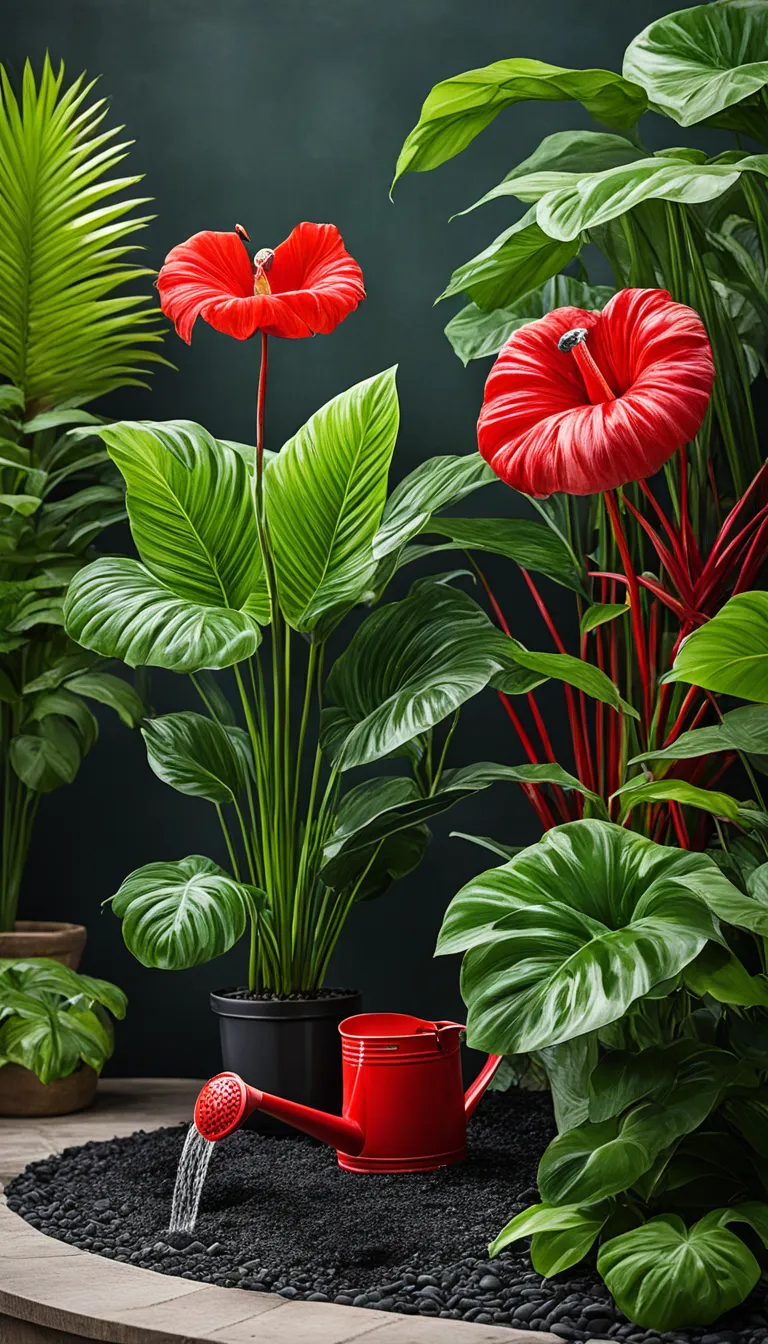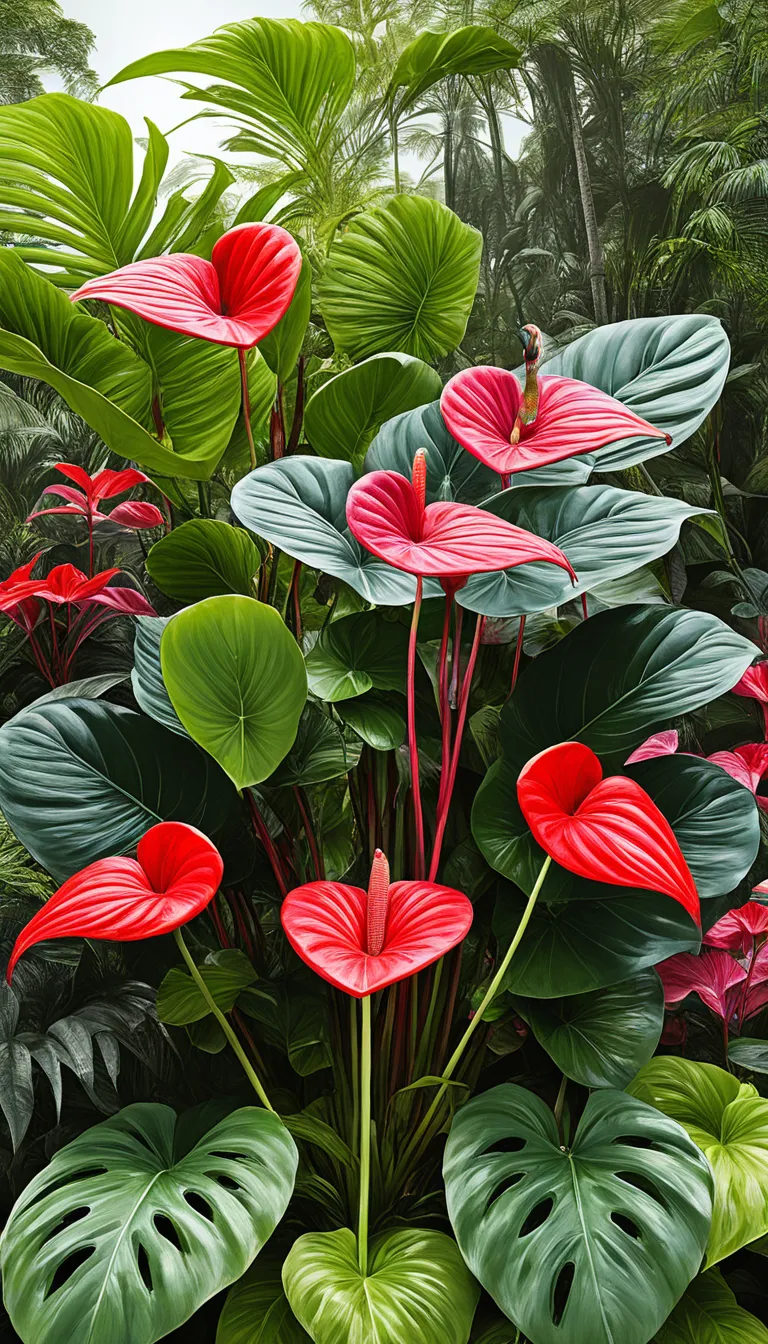Discover the allure of the Flamingo flower, known for its vibrant blooms and unique appearance that adds a tropical touch to any setting. The Flamingo flower, or Anthurium, is a stunning specimen that captures the essence of a tropical paradise with its glossy, heart-shaped leaves and striking, spadix flowers. Often mistaken for being part of the petal, the spadix is actually a spike of minute flowers closely packed together, surrounded by a colorful spathe, which most assume to be the ‘flower’.
Isn’t it fascinating how nature concocts such explosive displays of beauty? The Flamingo flower brings an element of surprise with its array of colors ranging from deep reds to soft pinks and even pure whites. These exotic blooms not only brighten up any room but also purify the air, making them a functional addition to your home decor.
Whether you’re a seasoned gardener or a budding plant enthusiast, the Flamingo flower is a joy to nurture. Its resilience and low maintenance requirements make it a popular choice for both indoor and outdoor gardening aficionados. So, why not add a splash of the tropics to your living space with the enchanting Flamingo flower?

What is Flamingo Flower?
The Flamingo Flower, also known by its scientific name Anthurium scherzerianum, is a striking plant that hails from the tropical rainforests of Central and South America. Its signature feature is the waxy, heart-shaped spathe that comes in a variety of vibrant colors, often mistaken for the flower itself. But, surprise! The real flower is the spadix, a spike of minute flowers nestled at the spathe’s center.
Flamingo Flowers are revered for their ability to bring an explosion of color to any environment. They are not just a feast for the eyes; these plants are also known for their air-purifying qualities. With their glossy green leaves and the year-round blooms, they’ve become a popular choice for both indoor and outdoor gardening enthusiasts. But what really sets the Flamingo Flower apart is its resilience and adaptability, making it a fitting addition to both novice and expert gardeners’ collections.
- Origin: Central and South America
- Family: Araceae
- Genus: Anthurium
- Bloom Color Varieties: Red, Pink, White, Orange
- Leaf Texture: Glossy and Leather-like
Whether you’re looking to add a touch of the tropics to your living room or create a vibrant focal point in your garden, the Flamingo Flower is a versatile beauty that won’t disappoint. So, are you ready to dive into the world of these exotic plants and let their charm transform your space?

How to Care for Flamingo Flower?
Have you ever wondered how to keep that stunning Flamingo Flower looking as spectacular as the day you brought it home? Fear not! Caring for this exotic beauty is simpler than you might think. Let’s dive into the essentials of Flamingo Flower care that will ensure your plant remains a vibrant centerpiece in your home or garden.
Firstly, watering your Flamingo Flower is like walking a tightrope – it’s all about balance. Too much water and you’ll drown it, too little and you’ll dehydrate it. Aim for consistently moist soil, but never soggy. A good rule of thumb is to water when the top inch of soil feels dry to the touch. Remember, this tropical plant loves humidity, so a light misting on the leaves can go a long way!
Now, let’s talk lighting. Just like a sunbather, the Flamingo Flower enjoys bright, indirect light. It’s like its own personal spa day, every day. But be cautious – direct sunlight can be too intense and cause its leaves to burn, and we certainly don’t want that!
When it comes to feeding, the Flamingo Flower isn’t a picky eater. During the growing season (spring and summer), a balanced, water-soluble fertilizer every month will keep it in tip-top shape. In the fall and winter, you can cut back to every other month. Think of it as its diet season.
- Water: Keep soil consistently moist, water when the top inch is dry.
- Light: Bright, indirect light is ideal. Avoid direct sunlight to prevent leaf burn.
- Humidity: Loves high humidity, consider misting leaves occasionally.
- Fertilizer: Use a balanced, water-soluble fertilizer monthly in spring and summer, bi-monthly in fall and winter.
By following these simple yet effective care tips, your Flamingo Flower will continue to explode with beauty and surprise anyone who lays eyes on it. So, are you ready to become a Flamingo Flower pro?

What are the Flamingo Flower Varieties?
The Flamingo Flower, or Anthurium, is not a one-size-fits-all plant. Its varieties are as diverse as they are stunning, each bringing its own unique flair to the table—or the garden, for that matter. Let’s dive into the explosion of colors and shapes that these tropical beauties offer.
Firstly, we have the Anthurium scherzerianum, recognizable by its curly spadix and heart-shaped, glossy leaves. It’s a classic that never fails to impress. Then, there’s the Anthurium andreanum, with its straight spadix and larger, waxy blooms that scream ‘look at me’!
But the variety doesn’t stop there. Here’s a quick rundown of some popular types:
- Anthurium ‘Pink Sensation’: As the name suggests, this variety boasts soft pink spathes that add a gentle pop of color.
- Anthurium ‘White Winner’: For those who prefer a more understated elegance, the pure white spathes of this variety are a perfect choice.
- Anthurium ‘Red Hot’: If you’re looking to add some drama, the deep red, almost velvety spathes of ‘Red Hot’ will certainly do the trick.
- Anthurium ‘Purple Velvet’: This variety is for the bold, with rich purple spathes that are both eye-catching and luxurious.
Choosing the right Flamingo Flower variety can be like selecting artwork for your living space; it’s all about what speaks to you and complements your style. Whether you’re drawn to the subtle, the bold, or the downright exotic, there’s a Flamingo Flower out there with your name on it.





